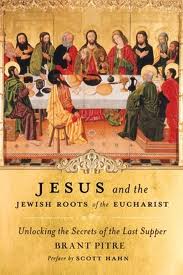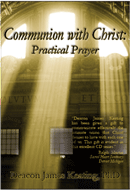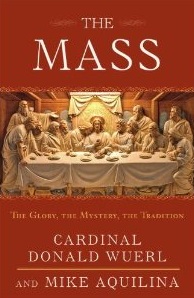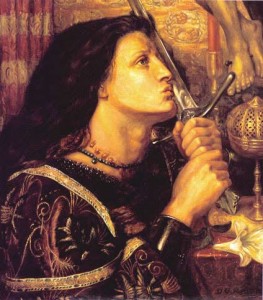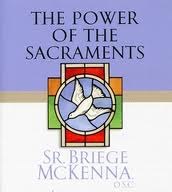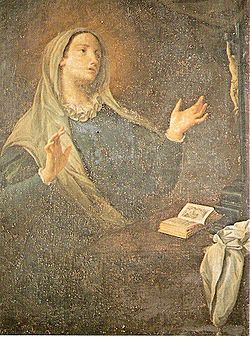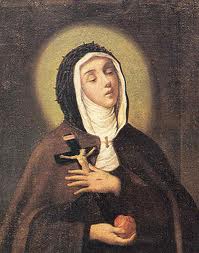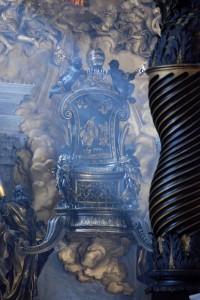 The Feast of the Chair of St. Peter is not so much a feast celebrating a “chair”, but more a feast celebrating what the chair symbolizes…the gift of the Papacy. I remember seeing it for the first time…not only the stunning piece used to preserve it by Bernini…but the whole altar piece setting at St. Peter’s…breathtaking. Almost every time I now see the presider’s chair at my local parish or the chair at our cathedral, I think of this chair, but also of the great unity it gives us with the entire Catholic Church under the leadership of the successor of St. Peter…our Holy Father. God bless the Holy Father, Pope Benedict XVI. Praise be to God for the gift of the Pa
The Feast of the Chair of St. Peter is not so much a feast celebrating a “chair”, but more a feast celebrating what the chair symbolizes…the gift of the Papacy. I remember seeing it for the first time…not only the stunning piece used to preserve it by Bernini…but the whole altar piece setting at St. Peter’s…breathtaking. Almost every time I now see the presider’s chair at my local parish or the chair at our cathedral, I think of this chair, but also of the great unity it gives us with the entire Catholic Church under the leadership of the successor of St. Peter…our Holy Father. God bless the Holy Father, Pope Benedict XVI. Praise be to God for the gift of the Pa pacy!
pacy!
Take a listen to Dr. Matthew Bunson talk to us about the importance of this feast in the podcast above.
Also here is the text from the Holy Father’s reflections on this feast from 2006Â from Vatican.va
“On this rock I will build my Church’
Dear Brothers and Sisters,
Today, the Latin-rite liturgy celebrates the Feast of the Chair of St Peter. This is a very ancient tradition, proven to have existed in Rome since the fourth century. On it we give thanks to God for the mission he entrusted to the Apostle Peter and his Successors.
“Cathedra” literally means the established seat of the Bishop, placed in the mother church of a diocese which for this reason is known as a “cathedral”; it is the symbol of the Bishop’s authority and in particular, of his “magisterium”, that is, the evangelical teaching which, as a successor of the Apostles, he is called to safeguard and to transmit to the Christian Community.
When a Bishop takes possession of the particular Church that has been entrusted to him, wearing his mitre and holding the pastoral staff, he sits on the cathedra. From this seat, as teacher and pastor, he will guide the journey of the faithful in faith, hope and charity.
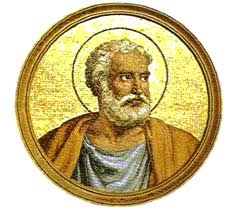 So what was the “Chair” of St Peter? Chosen by Christ as the “rock” on which to build the Church (cf. Mt 16:Â 18), he began his ministry in Jerusalem, after the Ascension of the Lord and Pentecost. The Church’s first “seat” was the Upper Room, and it is likely that a special place was reserved for Simon Peter in that room where Mary, Mother of Jesus, also prayed with the disciples. Therefore, we have the journey from Jerusalem, the newly born Church, to Antioch, the first centre of the Church formed from pagans and also still united with the Church that came from the Jews. Then Peter went to Rome, the centre of the Empire, the symbol of the “Orbis” – the “Urbs”, which expresses “Orbis”, the earth, where he ended his race at the service of the Gospel with martyrdom.
So what was the “Chair” of St Peter? Chosen by Christ as the “rock” on which to build the Church (cf. Mt 16:Â 18), he began his ministry in Jerusalem, after the Ascension of the Lord and Pentecost. The Church’s first “seat” was the Upper Room, and it is likely that a special place was reserved for Simon Peter in that room where Mary, Mother of Jesus, also prayed with the disciples. Therefore, we have the journey from Jerusalem, the newly born Church, to Antioch, the first centre of the Church formed from pagans and also still united with the Church that came from the Jews. Then Peter went to Rome, the centre of the Empire, the symbol of the “Orbis” – the “Urbs”, which expresses “Orbis”, the earth, where he ended his race at the service of the Gospel with martyrdom.
…This is testified by the most ancient Fathers of the Church, such as, for example, St Irenaeus, Bishop of Lyons, but who came from Asia Minor, who in his treatise Adversus Haereses, describes the Church of Rome as the “greatest and most ancient, known by all… founded and established in Rome by the two most glorious Apostles, Peter and Paul”; and he added:Â “The universal Church, that is, the faithful everywhere, must be in agreement with this Church because of her outstanding superiority” (III, 3, 2-3)….
Tertullian, a little later, said for his part:Â “How blessed is the Church of Rome, on which the Apostles poured forth all their doctrine along with their blood!” (De Praescriptione Hereticorum, 36).
Consequently, the Chair of the Bishop of Rome represents not only his service to the Roman community but also his mission as guide of the entire People of God.
Celebrating the “Chair” of Peter, therefore, as we are doing today, means attributing a strong spiritual significance to it and recognizing it as a privileged sign of the love of God, the eternal Good Shepherd, who wanted to gather his whole Church and lead her on the path of salvation.
Among the numerous testimonies of the Fathers, I would like to quote St Jerome’s. It is an extract from one of his letters, addressed to the Bishop of Rome. It is especially interesting precisely because it makes an explicit reference to the “Chair” of Peter, presenting it as a safe harbour of truth and peace.
This is what Jerome wrote:Â “I decided to consult the Chair of Peter, where that faith is found exalted by the lips of an Apostle; I now come to ask for nourishment for my soul there, where once I received the garment of Christ. I follow no leader save Christ, so I enter into communion with your beatitude, that is, with the Chair of Peter, for this I know is the rock upon which the Church is built” (cf. Le lettere I, 15, 1-2).
Dear brothers and sisters, in the apse of St Peter’s Basilica, as you know, is the monument to the Chair of the Apostle, a mature work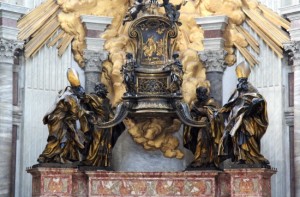 of Bernini. It is in the form of a great bronze throne supported by the statues of four Doctors of the Church: two from the West, St Augustine and St Ambrose, and two from the East:Â St John Chrysostom and St Athanasius.
of Bernini. It is in the form of a great bronze throne supported by the statues of four Doctors of the Church: two from the West, St Augustine and St Ambrose, and two from the East:Â St John Chrysostom and St Athanasius.
I invite you to pause before this evocative work which today can be admired, decorated with myriads of candles, and to say a special prayer for the ministry that God has entrusted to me. Raise your eyes to the alabaster glass window located directly above the Chair and call upon the Holy Spirit, so that with his enlightenment and power, he will always sustain my daily service to the entire Church. For this, as for your devoted attention, I thank you from my heart. –Vatican.va
Tags: bernini, catholic, catholic podcast, catholic prayer, cathollc spirituality, papacy, pope benedict xvi, st peter
This entry was posted on Tuesday, February 22nd, 2011 at 7:26 am
You can follow any responses to this entry through the RSS 2.0 feed.
Part 2…What a fantastic book, what a fantastic (and fun) interview with Dr. Brant Pitre, discussing “Jesus and the Jewish 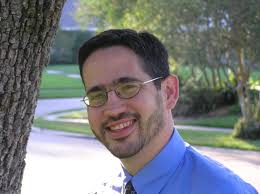 Roots of the Eucharist”. This book has what it takes to become a classic, similiar in importance as Dr. Scott Hahn’s “The Lamb’s Supper”!
Roots of the Eucharist”. This book has what it takes to become a classic, similiar in importance as Dr. Scott Hahn’s “The Lamb’s Supper”!
The description from the book says it best….“Jesus and the Jewish Roots of the Eucharist shines fresh light on the Last Supper by looking at it through Jewish eyes. Using his in-depth knowledge of the Bible and ancient Judaism, Dr. Brant Pitre answers questions such as: What was the Passover like at the time of Jesus? What were the Jewish hopes for the Messiah? What was Jesus’ purpose in instituting the Eucharist during the feast of Passover? And, most important of all, what did Jesus mean when he said, “This is my body… This is my bloodâ€?
To answer these questions, Pitre explores ancient Jewish beliefs about the Passover of the Messiah, the miraculous Manna from heaven, and the mysterious Bread of the Presence. As he shows, these three keys—the Passover, the Manna, and the Bread of the Presence—have the power to unlock the original meaning of the Eucharistic words of Jesus. Along the way, Pitre also explains how Jesus united the Last Supper to his death on Good Friday and his Resurrection on Easter Sunday.
Inspiring and informative, Jesus and the Jewish Roots of the Eucharist is a groundbreaking work that is sure to illuminate one of the greatest mysteries of the Christian faith: the mystery of Jesus’ presence in “the breaking of the bread.â€
[powerpress]
and be sure to check out Dr. Brant Pitre’s excellent website!
Tags: ancient judaism, brant pitre, catholic, catholic podcast, catholic prayer, cathollc spirituality, doubleday religion, eucharist, Jesus, mysteries, work
This entry was posted on Monday, February 14th, 2011 at 7:58 am
You can follow any responses to this entry through the RSS 2.0 feed.
Episode 14 -The Way of Mystery: The Eucharist and Moral Living– The Eucharist summons us like a beacon.  Even in the face of scandal, the moral authority of the Church shines through the Eucharist and challenges us to follow Christ in moving forward and allowing our hearts to be transformed. Mortal sin, what is it and how does it effect our relationship with the Eucharist…with Christ? Being present at mass even if you shouldn’t receive…not allowing yourself to be separated from worship.
Even in the face of scandal, the moral authority of the Church shines through the Eucharist and challenges us to follow Christ in moving forward and allowing our hearts to be transformed. Mortal sin, what is it and how does it effect our relationship with the Eucharist…with Christ? Being present at mass even if you shouldn’t receive…not allowing yourself to be separated from worship.
[powerpress]
Deacon James Keating, PhD, the director of Theological Formation for the Institute for Priestly Formation, located at Creighton University, in Omaha, is making available to â€Discerning Hearts†and all who listen, his series of programs entitled “The Way of Mysteryâ€.
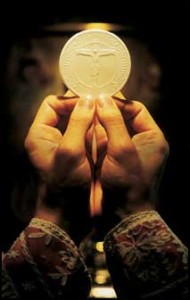 The Vatican II documents remind us that the spiritual journey is not made in a vacuum, that God has chosen to save us, not individually, but as The People of God. The Eucharist must help Christians to make their choices by discerning out of Christ’s paschal mystery. For this process to take place, however, Christians must first understand how the Eucharist puts them in touch with Christ’s passion, death, and resurrection, and what concrete implications being in touch with this mystery has for their daily lives.
The Vatican II documents remind us that the spiritual journey is not made in a vacuum, that God has chosen to save us, not individually, but as The People of God. The Eucharist must help Christians to make their choices by discerning out of Christ’s paschal mystery. For this process to take place, however, Christians must first understand how the Eucharist puts them in touch with Christ’s passion, death, and resurrection, and what concrete implications being in touch with this mystery has for their daily lives.
For more information on the “Institute of Priestly Formation†and for other material available by Deacon Keating, just click here
Don’t forget to pickup a copy of “Communion with Christ†, it is one of the best audio sets on prayer…ever!
Check out Deacon Keating’s “Discerning Heart†page
Tags: catholic, catholic podcast, catholic prayer, cathollc spirituality, Christ Episode 14, creighton university, deacon, Deacon James Keating, institute for priestly formation, james keating, paschal mystery, the eucharist, theological formation, way of mystery
This entry was posted on Saturday, February 12th, 2011 at 5:23 pm
You can follow any responses to this entry through the RSS 2.0 feed.
What a fantastic book, what a fantastic (and fun) interview with Dr. Brant Pitre, discussing “Jesus and the Jewish  Roots of the Eucharist”. This book has what it takes to become a classic, similiar in importance as Dr. Scott Hahn’s “The Lamb’s Supper”!
Roots of the Eucharist”. This book has what it takes to become a classic, similiar in importance as Dr. Scott Hahn’s “The Lamb’s Supper”!
The description from the book says it best….“Jesus and the Jewish Roots of the Eucharist shines fresh light on the Last Supper by looking at it through Jewish eyes. Using his in-depth knowledge of the Bible and ancient Judaism, Dr. Brant Pitre answers questions such as: What was the Passover like at the time of Jesus? What were the Jewish hopes for the Messiah? What was Jesus’ purpose in instituting the Eucharist during the feast of Passover? And, most important of all, what did Jesus mean when he said, “This is my body… This is my bloodâ€?
To answer these questions, Pitre explores ancient Jewish beliefs about the Passover of the Messiah, the miraculous Manna from heaven, and the mysterious Bread of the Presence. As he shows, these three keys—the Passover, the Manna, and the Bread of the Presence—have the power to unlock the original meaning of the Eucharistic words of Jesus. Along the way, Pitre also explains how Jesus united the Last Supper to his death on Good Friday and his Resurrection on Easter Sunday.
Inspiring and informative, Jesus and the Jewish Roots of the Eucharist is a groundbreaking work that is sure to illuminate one of the greatest mysteries of the Christian faith: the mystery of Jesus’ presence in “the breaking of the bread.â€
and be sure to check out Dr. Brant Pitre’s excellent website!
Tags: brant pitre, catholic, catholic podcast, catholic prayer, cathollc spirituality, doubleday religion, feast of passover, Jesus, jewish roots, last supper, manna from heaven, mysteries, work
This entry was posted on Friday, February 11th, 2011 at 12:38 am
You can follow any responses to this entry through the RSS 2.0 feed.
Episode 13 -The Way of Mystery: The Eucharist and Moral Living–  the spiritual life and moral living… understanding the journey through the Purgative and Illuminative Way and their role in the moral life.
the spiritual life and moral living… understanding the journey through the Purgative and Illuminative Way and their role in the moral life.
[powerpress]
Deacon James Keating, PhD, the director of Theological Formation for the Institute for Priestly Formation, located at Creighton University, in Omaha, is making available to â€Discerning Hearts†and all who listen, his series of programs entitled “The Way of Mysteryâ€.
 The Vatican II documents remind us that the spiritual journey is not made in a vacuum, that God has chosen to save us, not individually, but as The People of God. The Eucharist must help Christians to make their choices by discerning out of Christ’s paschal mystery. For this process to take place, however, Christians must first understand how the Eucharist puts them in touch with Christ’s passion, death, and resurrection, and what concrete implications being in touch with this mystery has for their daily lives.
The Vatican II documents remind us that the spiritual journey is not made in a vacuum, that God has chosen to save us, not individually, but as The People of God. The Eucharist must help Christians to make their choices by discerning out of Christ’s paschal mystery. For this process to take place, however, Christians must first understand how the Eucharist puts them in touch with Christ’s passion, death, and resurrection, and what concrete implications being in touch with this mystery has for their daily lives.
For more information on the “Institute of Priestly Formation†and for other material available by Deacon Keating, just click here
Don’t forget to pickup a copy of “Communion with Christ†, it is one of the best audio sets on prayer…ever!
Check out Deacon Keating’s “Discerning Heart†page
Tags: catholic, catholic podcast, catholic prayer, cathollc spirituality, Deacon James Keating, discerning heart, illuminative way, institute for priestly formation, james keating, paschal mystery, purgative, spiritual journey, the eucharist, theological formation, virutes, way of mystery
This entry was posted on Sunday, February 6th, 2011 at 3:47 pm
You can follow any responses to this entry through the RSS 2.0 feed.
Episode 12 -The Way of Mystery: The Eucharist and Moral Living–  The Liturgy of the Eucharist part 4 : the Communion Rite…The moment of radical surrender…can we do it? We when come forward to communion, what are doing…what are we saying? Will we allow ourselves to be transformed? The moment of silence…will we allow ourselves to be transformed within so we can go out to transform the culture for Christ?
The Liturgy of the Eucharist part 4 : the Communion Rite…The moment of radical surrender…can we do it? We when come forward to communion, what are doing…what are we saying? Will we allow ourselves to be transformed? The moment of silence…will we allow ourselves to be transformed within so we can go out to transform the culture for Christ?
[powerpress]
Deacon James Keating, PhD, the director of Theological Formation for the Institute for Priestly Formation, located at Creighton University, in Omaha, is making available to â€Discerning Hearts†and all who listen, his series of programs entitled “The Way of Mysteryâ€.
 The Vatican II documents remind us that the spiritual journey is not made in a vacuum, that God has chosen to save us, not individually, but as The People of God. The Eucharist must help Christians to make their choices by discerning out of Christ’s paschal mystery. For this process to take place, however, Christians must first understand how the Eucharist puts them in touch with Christ’s passion, death, and resurrection, and what concrete implications being in touch with this mystery has for their daily lives.
The Vatican II documents remind us that the spiritual journey is not made in a vacuum, that God has chosen to save us, not individually, but as The People of God. The Eucharist must help Christians to make their choices by discerning out of Christ’s paschal mystery. For this process to take place, however, Christians must first understand how the Eucharist puts them in touch with Christ’s passion, death, and resurrection, and what concrete implications being in touch with this mystery has for their daily lives.
For more information on the “Institute of Priestly Formation†and for other material available by Deacon Keating, just click here
Don’t forget to pickup a copy of “Communion with Christ†, it is one of the best audio sets on prayer…ever!
Check out Deacon Keating’s “Discerning Heart†page
Tags: catholic, catholic podcast, catholic prayer, cathollc spirituality, Christ Episode 12, communion rite, creighton university, Deacon James Keating, eucharist, institute for priestly formation, james keating, paschal mystery, the eucharist, theological formation, way of mystery
This entry was posted on Sunday, January 30th, 2011 at 12:53 pm
You can follow any responses to this entry through the RSS 2.0 feed.
“The Mass: The Glory, The Mystery, The Tradition” is absolutely fantastic! This is the book so many of us have been waiting for and leave it to Mike Aquilina, along with co-author, his eminence, Cardinal Donald Wuerl to bring it to us. Every Catholic household should have a copy of this richly satisfying primer to the great prayer of the Church…The Holy Mass! Beautiful pictures, historical background, the essential how, what, where, why of every aspect of the mass, this work is neither too “light” nor too “heavy”, but just right to deeply educate us all on the celebration, while encouraging us all to dive deeper into it’s mysteries. And with changes coming to the Mass in late 2011, now is the time to pick this up! No excuses…this is a must!
have been waiting for and leave it to Mike Aquilina, along with co-author, his eminence, Cardinal Donald Wuerl to bring it to us. Every Catholic household should have a copy of this richly satisfying primer to the great prayer of the Church…The Holy Mass! Beautiful pictures, historical background, the essential how, what, where, why of every aspect of the mass, this work is neither too “light” nor too “heavy”, but just right to deeply educate us all on the celebration, while encouraging us all to dive deeper into it’s mysteries. And with changes coming to the Mass in late 2011, now is the time to pick this up! No excuses…this is a must!
Also check out more by Mike Aquilina on his Discerning Hearts page
[powerpress]
Tags: cardinal donald wuerl, catholic, catholic podcast, catholic prayer, cathollc spirituality, mike aquilina
This entry was posted on Friday, January 28th, 2011 at 6:12 am
You can follow any responses to this entry through the RSS 2.0 feed.
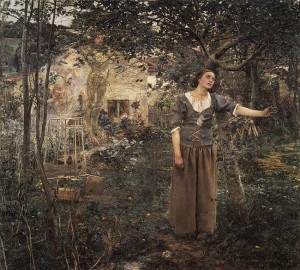 ommitment to sacramental life and to prayer: daily participation in Mass, frequent Confession and Communion and long periods of silent prayer before the Crucified One or the image of Our Lady. The young French peasant girl’s compassion and dedication in the face of her people’s suffering were intensified by her mystical relationship with God. One of the most original aspects of this young woman’s holiness was precisely this link between mystical experience and political mission. The years of her hidden life and her interior development were followed by the brief but intense two years of her public life: a year of action and a year of passion. At the beginning of 1429, Joan began her work of liberation. The many witnesses show us this young woman who was only 17 years old as a very strong and determined person, able to convince people who felt insecure and discouraged. Overcoming all obstacles, she met the Dauphin of France, the future King Charles VII, who subjected her to an examination in Poitiers by some theologians of the university. Their opinion was positive: they saw in her nothing evil, only a good Christian. On 22 March 1429 Joan dictated an important letter to the King of England and to his men at arms who were besieging the city of Orléans (ibid., pp. 221-222). Hers was a true proposal of peace in justice between the two Christian peoples in light of the Name of Jesus and Mary, but it was rejected and Joan had to gird herself to fight for the city’s liberation which took place on 8 May. The other culminating moment of her political action was the coronation of King Charles VII in Rheims on 17 July 1429. For a whole year, Joan lived with the soldiers, carrying out among them a true mission of evangelization. Many of them testified to her goodness, her courage and her extraordinary purity. She was called by all and by herself “La pucelle†(“the Maidâ€), that is, virgin. Joan’s passion began on 23 May 1430, when she fell into enemy hands and was taken prisoner. On 23 December she was led to the city of Rouen. There the long and dramatic Trial of Condemnation took place, that began in February 1431 and ended on 30 May with her being burned at the stake.
ommitment to sacramental life and to prayer: daily participation in Mass, frequent Confession and Communion and long periods of silent prayer before the Crucified One or the image of Our Lady. The young French peasant girl’s compassion and dedication in the face of her people’s suffering were intensified by her mystical relationship with God. One of the most original aspects of this young woman’s holiness was precisely this link between mystical experience and political mission. The years of her hidden life and her interior development were followed by the brief but intense two years of her public life: a year of action and a year of passion. At the beginning of 1429, Joan began her work of liberation. The many witnesses show us this young woman who was only 17 years old as a very strong and determined person, able to convince people who felt insecure and discouraged. Overcoming all obstacles, she met the Dauphin of France, the future King Charles VII, who subjected her to an examination in Poitiers by some theologians of the university. Their opinion was positive: they saw in her nothing evil, only a good Christian. On 22 March 1429 Joan dictated an important letter to the King of England and to his men at arms who were besieging the city of Orléans (ibid., pp. 221-222). Hers was a true proposal of peace in justice between the two Christian peoples in light of the Name of Jesus and Mary, but it was rejected and Joan had to gird herself to fight for the city’s liberation which took place on 8 May. The other culminating moment of her political action was the coronation of King Charles VII in Rheims on 17 July 1429. For a whole year, Joan lived with the soldiers, carrying out among them a true mission of evangelization. Many of them testified to her goodness, her courage and her extraordinary purity. She was called by all and by herself “La pucelle†(“the Maidâ€), that is, virgin. Joan’s passion began on 23 May 1430, when she fell into enemy hands and was taken prisoner. On 23 December she was led to the city of Rouen. There the long and dramatic Trial of Condemnation took place, that began in February 1431 and ended on 30 May with her being burned at the stake.
It was a great and solemn Trial, at which two ecclesiastical judges presided, Bishop Pierre Cauchon and the Inquisitor Jean le Maistre, but in fact it was conducted entirely by a large group of theologians from the renowned University of Paris, who took part in the Trial as assessors. They were French clerics, who, on the side politically opposed to Joan’s, had a priori a negative opinion of both her and her mission. This Trial is a distressing page in the history of holiness and also an illuminating page on the mystery of the Church which, according to the words of the Second Vatican Council, is “at once holy and always in need of purification†(Lumen Gentium, n. 8).
The Trial was the dramatic encounter between this Saint and her judges, who were clerics. Joan was accused and convicted by them, even condemned as a heretic and sent to the terrible death of being burned at the stake. Unlike the holy theologians who had illuminated the University of Paris, such as St Bonaventure, St Thomas Aquinas and Bl. Duns Scotus, of whom I have spoken in several Catecheses, these judges were theologians who lacked charity and the humility to see God’s action in this young woman. The words of Jesus, who said that God’s mysteries are revealed to those who have a child’s heart while they remain hidden to the learned and the wise who have no humility (cf. Lk 10:21), spring to mind. Thus, Joan’s judges were radically incapable of understanding her or of perceiving the beauty of her soul. They did not know that they were condemning a Saint. Joan’s appeal to the Pope, on 24 May, was rejected by the tribunal. On the morning of 30 May, in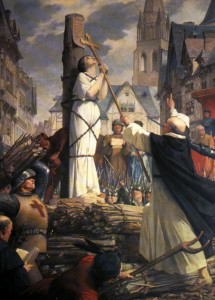 prison, she received Holy Communion for the last time and was immediately led to her torture in the Old Market Square. She asked one of the priests to hold up a processional Cross in front of the stake. Thus she died, her gaze fixed upon the Crucified Jesus and crying out several times the Name of Jesus (PNul, I, p. 457; cf. Catechism of the Catholic Church, n. 435). About 25 years later the Trial of Nullity, which opened under the authority of Pope Calixtus III, ended with a solemn sentence that declared the condemnation null and void (7 July 1456; PNul, II, pp. 604-610). This long trial, which collected the evidence of witnesses and the opinions of many theologians, all favourable to Joan, sheds light on her innocence and on her perfect fidelity to the Church. Joan of Arc was subsequently canonized by Benedict XV in 1920. Dear brothers and sisters, the Name of Jesus, invoked by our Saint until the very last moments of her earthly life was like the continuous breathing of her soul, like the beating of her heart, the centre of her whole life. The Mystery of the Charity of Joan of Arc which so fascinated the poet Charles Péguy was this total love for Jesus and for her neighbour in Jesus and for Jesus. This Saint had understood that Love embraces the whole of the reality of God and of the human being, of Heaven and of earth, of the Church and of the world. Jesus always had pride of place in her life, in accordance to her beautiful affirmation: “We must serve God first†(PCon, I, p. 288; cf. Catechismo della Chiesa Cattolica, n. 223). Loving him means always doing his will. She declared with total surrendur and trust: “I entrust myself to God my Creator, I love him with my whole my heart†(PCon, I, p. 337). With the vow of virginity, Joan consecrated her whole being exclusively to the one Love of Jesus: “it was the promise that she made to Our Lord to preserve the virginity of her body and her mind well†(PCon, I, pp. 149-150). Virginity of soul is the state of grace, a supreme value, for her more precious than life. It is a gift of God which is to be received and preserved with humility and trust. One of the best known texts of the first Trial concerns precisely this: “Asked if she knew that she was in God’s grace, she replied: ‘If I am not, may it please God to put me in it; if I am, may it please God to keep me there’†(ibid., p. 62; cf. Catechism of the Catholic Church, n. 2005).
prison, she received Holy Communion for the last time and was immediately led to her torture in the Old Market Square. She asked one of the priests to hold up a processional Cross in front of the stake. Thus she died, her gaze fixed upon the Crucified Jesus and crying out several times the Name of Jesus (PNul, I, p. 457; cf. Catechism of the Catholic Church, n. 435). About 25 years later the Trial of Nullity, which opened under the authority of Pope Calixtus III, ended with a solemn sentence that declared the condemnation null and void (7 July 1456; PNul, II, pp. 604-610). This long trial, which collected the evidence of witnesses and the opinions of many theologians, all favourable to Joan, sheds light on her innocence and on her perfect fidelity to the Church. Joan of Arc was subsequently canonized by Benedict XV in 1920. Dear brothers and sisters, the Name of Jesus, invoked by our Saint until the very last moments of her earthly life was like the continuous breathing of her soul, like the beating of her heart, the centre of her whole life. The Mystery of the Charity of Joan of Arc which so fascinated the poet Charles Péguy was this total love for Jesus and for her neighbour in Jesus and for Jesus. This Saint had understood that Love embraces the whole of the reality of God and of the human being, of Heaven and of earth, of the Church and of the world. Jesus always had pride of place in her life, in accordance to her beautiful affirmation: “We must serve God first†(PCon, I, p. 288; cf. Catechismo della Chiesa Cattolica, n. 223). Loving him means always doing his will. She declared with total surrendur and trust: “I entrust myself to God my Creator, I love him with my whole my heart†(PCon, I, p. 337). With the vow of virginity, Joan consecrated her whole being exclusively to the one Love of Jesus: “it was the promise that she made to Our Lord to preserve the virginity of her body and her mind well†(PCon, I, pp. 149-150). Virginity of soul is the state of grace, a supreme value, for her more precious than life. It is a gift of God which is to be received and preserved with humility and trust. One of the best known texts of the first Trial concerns precisely this: “Asked if she knew that she was in God’s grace, she replied: ‘If I am not, may it please God to put me in it; if I am, may it please God to keep me there’†(ibid., p. 62; cf. Catechism of the Catholic Church, n. 2005).
Our Saint lived prayer in the form of a continuous dialogue with the Lord who also illuminated her dialogue with the judges and gave her peace and security. She asked him with trust: Sweetest God, in honour of your holy Passion, I ask you, if you love me, to show me how I must answer these men of the Church†(PCon, I, p. 252). Joan saw Jesus as the “King of Heaven and of the earthâ€. She therefore had painted on her standard the image of “Our Lord holding the world†(ibid., p. 172): the emblem of her political mission. The liberation of her people was a work of human justice which Joan carried out in charity, for love of Jesus. Her holiness is a beautiful example for lay people engaged in politics, especially in the most difficult situations. Faith is the light that guides every decision, as a century later another great Saint, the Englishman Thomas More, was to testify.
In Jesus Joan contemplated the whole reality of the Church, the “Church triumphant†of Heaven, as well as the “Church militant†on earth. According to her words, “About Jesus Christ and the Church, I simply know they’re just one thing†(ibid., p. 166). This affirmation, cited in theCatechism of the Catholic Church (n. 795), has a truly heroic character in the context of theTrial of Condemnation, before her judges, men of the Church who were persecuting and condemning her. In the Love of Jesus Joan found the strength to love the Church to the very end, even at the moment she was sentenced. I like to recall that St Joan of Arc had a profound influence on a young Saint of the modern age: Thérèse of the Child Jesus. In the context of a completely different life, spent in the cloister, the Carmelite of Lisieux felt very close to Joan, living in the heart of the Church and participating in Christ’s suffering for the world’s salvation. The Church has brought them together as Patronesses of France, after the Virgin Mary. St Thérèse expressed her desire to die, like Joan, with the Name of Jesus on her lips (Manoscritto B, 3r), and she was motivated by the same great love for Jesus and her neighbour, lived in consecrated virginity. Dear brothers and sisters, with her luminous witness St Joan of Arc invites us to a high standard of Christian living: to make prayer the guiding motive of our days; to have full trust in doing God’s will, whatever it may be; to live charity without favouritism, without limits and drawing, like her, from the Love of Jesus a profound love for the Church. Thank you.
Tags: catholic, catholic church, catholic podcast, catholic prayer, cathollc spirituality, Crucified Jesus, French Saint, Joan of Arc
This entry was posted on Wednesday, January 19th, 2011 at 12:12 am
You can follow any responses to this entry through the RSS 2.0 feed.
Part 2 of 3…Sr. Briege McKenna O.S.C. is a tremendous blessing for all of us in the Church! “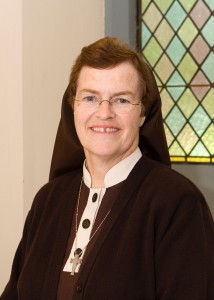 The Power of the Sacraments” is a beautiful work which helps us all to appreciate the gift of grace that flows through the sacraments. There is such a hunger in the hearts of God’s children today for healing and peace. Sr. Briege, in her beautiful maternal nurturing way, helps us to see that the answer is right in front of us reaching out to us right now…he is Jesus Christ. “Miracles Do Happen” is her beautiful book recounting her miraculous healing and her call to mission to the world. It also expresses her great love and concern for the priesthood. Her insights are tremendous…her love for Christ and her bride, the Church, is a glorious witness and light for today’s world. She is truly one of the most inspiring persons I have ever encountered!
The Power of the Sacraments” is a beautiful work which helps us all to appreciate the gift of grace that flows through the sacraments. There is such a hunger in the hearts of God’s children today for healing and peace. Sr. Briege, in her beautiful maternal nurturing way, helps us to see that the answer is right in front of us reaching out to us right now…he is Jesus Christ. “Miracles Do Happen” is her beautiful book recounting her miraculous healing and her call to mission to the world. It also expresses her great love and concern for the priesthood. Her insights are tremendous…her love for Christ and her bride, the Church, is a glorious witness and light for today’s world. She is truly one of the most inspiring persons I have ever encountered!
[powerpress]
Click here to be taken to Sr. Briege’s website “St. Clare Sisters Retreat Ministry”
You can find both of Sr. Briege McKenna’s books here
St. Clare Sisters Retreat Ministry
P.O. Box 1559
Palm Harbor, FL 34682, U.S.A.
Office: #727-786-3821
Fax: #727-787-3741
Prayerline: #727-781-5906
www.sisterbriege.com
For more Sister Briege on Inside the Pages:
IP#64 Sr. Briege McKenna – The Power of the Sacraments part 1 on Inside the Pages
IP#66 Sr. Briege McKenna – The Power of the Sacraments part 3 on Inside the Pages
prayer@sisterbriege.com
info@sisterbriege.com
Tags: Briege McKenna, catholic, catholic podcast, catholic prayer, cathollc spirituality
This entry was posted on Monday, January 17th, 2011 at 7:44 am
You can follow any responses to this entry through the RSS 2.0 feed.
VATICAN CITY, 12 JAN 2011 (vatican.va) –
Dear Brothers and Sisters,
After Catherine of Siena and Catherine of Bologna, today I would like to speak to you about another Saint: Catherine of Genoa, known above all for her vision of purgatory. The text that describes her life and thought was published in this Ligurian city in 1551. It is in three sections: her Vita [Life], properly speaking, the Dimostratione et dechiaratione del purgatorio — better known as Treatise on purgatory — and her Dialogo tra l’anima e il corpo (cf. Libro de la Vita mirabile et dottrina santa, de la beata Caterinetta da Genoa. Nel quale si contiene una utile et catholica dimostratione et dechiaratione del purgatorio, Genoa 1551). The final version was written by Catherine’s confessor, Fr Cattaneo Marabotto.
Catherine was born in Genoa in 1447. She was the youngest of five. Her father, Giacomo Fieschi, died when she was very young. Her mother, Francesca di Negro provided such an effective Christian education that the elder of her two daughters became a religious.
When Catherine was 16, she was given in marriage to Giuliano Adorno, a man who after various trading and military experiences in the Middle East had returned to Genoa in order to marry.
Married life was far from easy for Catherine, partly because of the character of her husband who was given to gambling. Catherine herself was at first induced to lead a worldly sort of life in which, however, she failed to find serenity. After 10 years, her heart was heavy with a deep sense of emptiness and bitterness.
A unique experience on 20 March 1473 sparked her conversion. She had gone to the Church of San Benedetto in the monastery of Nostra Signora delle Grazie [Our Lady of Grace], to make her confession and, kneeling before the priest, “receivedâ€, as she herself wrote, “a wound in my heart from God’s immense loveâ€. It came with such a clear vision of her own wretchedness and shortcomings and at the same time of God’s goodness, that she almost fainted.
Her heart was moved by this knowledge of herself — knowledge of the empty life she was leading and of the goodness of God. This experience prompted the decision that gave direction to her whole life. She expressed it in the words: “no longer the world, no longer sin†(cf. Vita Mirabile, 3rv). Catherine did not stay to make her Confession.
On arriving home she entered the remotest room and spent a long time weeping. At that moment she received an inner instruction on prayer and became aware of God’s immense love for her, a sinner. It was a spiritual experience she had no words to  describe ( cf. Vita Mirabile, 4r).
It was on this occasion that the suffering Jesus appeared to her, bent beneath the Cross, as he is often portrayed in the Saint’s iconography. A few days later she returned to the priest to make a good confession at last. It was here that began the “life of purification†which for many years caused her to feel constant sorrow for the sins she had committed and which spurred her to impose forms of penance and sacrifice upon herself, in order to show her love to God.
On this journey Catherine became ever closer to the Lord until she attained what is called “unitive lifeâ€, namely, a relationship of profound union with God.
In her Vita it is written that her soul was guided and instructed from within solely by the sweet love of God which gave her all she needed. Catherine surrendered herself so totally into the hands of the Lord that she lived, for about 25 years, as she wrote, “without the assistance of any creature, taught and governed by God alone†(Vita, 117r-118r), nourished above all by constant prayer and by Holy Communion which she received every day, an unusual practice in her time. Only many years later did the Lord give her a priest who cared for her soul.
Catherine was always reluctant to confide and reveal her experience of mystical communion with God, especially because of the deep humility she felt before the Lord’s graces. The prospect of glorifying him and of being able to contribute to the spiritual journey of others alone spurred her to recount what had taken place within her, from the moment of her conversion, which is her original and fundamental experience.
The place of her ascent to mystical peaks was Pammatone Hospital, the largest hospital complex in Genoa, of which she was director and animator. Hence Catherine lived a totally active existence despite the depth of her inner life. In Pammatone a group of followers, disciples and collaborators formed around her, fascinated by her life of faith and her charity.
Indeed her husband, Giuliano Adorno, was so so won over that he gave up his dissipated life, became a Third Order Franciscan and moved into the hospital to help his wife.
Catherine’s dedication to caring for the sick continued until the end of her earthly life on 15 September 1510. From her conversion until her death there were no extraordinary events but two elements characterize her entire life: on the one hand her mystical experience, that is, the profound union with God, which she felt as spousal union, and on the other, assistance to the sick, the organization of the hospital and service to her neighbour, especially the neediest and the most forsaken. These two poles, God and neighbour, totally filled her life, virtually all of which she spent within the hospital walls.
Dear friends, we must never forget that the more we love God and the more constantly we pray, the better we will succeed in truly loving those who surround us, who are close to us, so that we can see in every person the Face of the Lord whose love knows no bounds and makes no distinctions. The mystic does not create distance from others or an abstract life, but rather approaches other people so that they may begin to see and act with God’s eyes and heart.
Catherine’s thought on purgatory, for which she is particularly well known, is summed up in the last two parts of the book mentioned above: The Treatise on purgatory and the Dialogues between the body and the soul. It is important to note that Catherine, in her mystical experience, never received specific revelations on purgatory or on the souls being purified there. Yet, in the writings inspired by our Saint, purgatory is a central element and the description of it has characteristics that were original in her time.
The first original passage concerns the “place†of the purification of souls. In her day it was depicted mainly using images linked to space: a certain space was conceived of in which purgatory was supposed to be located.
Catherine, however, did not see purgatory as a scene in the bowels of the earth: for her it is not an exterior but rather an interior fire. This is purgatory: an inner fire.
The Saint speaks of the Soul’s journey of purification on the way to full communion with God, starting from her own experience of profound sorrow for the sins committed, in comparison with God’s infinite love (cf. Vita Mirabile, 171v).
We heard of the moment of conversion when Catherine suddenly became aware of God’s goodness, of the infinite distance of her own life from this goodness and of a burning fire within her. And this is the fire that purifies, the interior fire of purgatory. Here too is an original feature in comparison with the thought of her time.
In fact, she does not start with the afterlife in order to recount the torments of purgatory — as was the custom in her time and perhaps still is today — and then to point out the way to purification or conversion. Rather our Saint begins with the inner experience of her own life on the way to Eternity.
“The soulâ€, Catherine says, “presents itself to God still bound to the desires and suffering that derive from sin and this makes it impossible for it to enjoy the beatific vision of Godâ€. Catherine asserts that God is so pure and holy that a soul stained by sin cannot be in the presence of the divine majesty (cf. Vita Mirabile, 177r).
We too feel how distant we are, how full we are of so many things that we cannot see God. The soul is aware of the immense love and perfect justice of God and consequently suffers for having failed to respond in a correct and perfect way to this love; and love for God itself becomes a flame, love itself cleanses it from the residue of sin.
In Catherine we can make out the presence of theological and mystical sources on which it was normal to draw in her time. In particular, we find an image typical of Dionysius the Areopagite: the thread of gold that links the human heart to God himself. When God purified man, he bound him with the finest golden thread, that is, his love, and draws him toward himself with such strong affection that man is as it were “overcome and won over and completely beside himselfâ€.
Thus man’s heart is pervaded by God’s love that becomes the one guide, the one driving force of his life (cf. Vita Mirabile, 246rv). This situation of being uplifted towards God and of surrender to his will, expressed in the image of the thread, is used by Catherine to express the action of divine light on the souls in purgatory, a light that purifies and raises them to the splendour of the shining radiance of God (cf. Vita Mirabile, 179r).
Dear friends, in their experience of union with God, Saints attain such a profound knowledge of the divine mysteries in which love and knowledge interpenetrate, that they are of help to theologians themselves in their commitment to study, to intelligentia fidei, to an intelligentia of the mysteries of faith, to attain a really deeper knowledge of the mysteries of faith, for example, of what purgatory is.
With her life St Catherine teaches us that the more we love God and enter into intimacy with him in prayer the more he makes himself known to us, setting our hearts on fire with his love.
In writing about purgatory, the Saint reminds us of a fundamental truth of faith that becomes for us an invitation to pray for the deceased so that they may attain the beatific vision of God in the Communion of Saints (cf. Catechism of the Catholic Church, n. 1032).
Moreover the humble, faithful and generous service in Pammatone Hospital that the Saint rendered throughout her life is a shining example of charity for all and an encouragement, especially for women who, with their precious work enriched by their sensitivity and attention to the poorest and neediest, make a fundamental contribution to society and to the Church. Many thanks.
For more on St. Catherine of Genoa visit Discerning Hearts post St. Catherine of Genoa…it’s all about Divine Love
Tags: benedict xvi, Catherine of Genoa, catholic, catholic podcast, catholic prayer, cathollc spirituality, experience, love, mystic, mystic of the Church, mystical communion, mystical experience, purgatory, relationship, souls in purgatory, st catherine of genoa, Vita Mirabile, women of the middle ages
This entry was posted on Wednesday, January 12th, 2011 at 1:01 pm
You can follow any responses to this entry through the RSS 2.0 feed.
Episode 9 -The Way of Mystery: The Eucharist and Moral Living–  The Liturgy of the Eucharist part 1 : The offertory and the priesthood…what is the role of the priest in the sacrifice of the Mass and what are some of the challenges faced by the priest today.
The Liturgy of the Eucharist part 1 : The offertory and the priesthood…what is the role of the priest in the sacrifice of the Mass and what are some of the challenges faced by the priest today.
[powerpress]
Deacon James Keating, PhD, the director of Theological Formation for the Institute for Priestly Formation, located at Creighton University, in Omaha, is making available to â€Discerning Hearts†and all who listen, his series of programs entitled “The Way of Mysteryâ€.
 The Vatican II documents remind us that the spiritual journey is not made in a vacuum, that God has chosen to save us, not individually, but as The People of God. The Eucharist must help Christians to make their choices by discerning out of Christ’s paschal mystery. For this process to take place, however, Christians must first understand how the Eucharist puts them in touch with Christ’s passion, death, and resurrection, and what concrete implications being in touch with this mystery has for their daily lives.
The Vatican II documents remind us that the spiritual journey is not made in a vacuum, that God has chosen to save us, not individually, but as The People of God. The Eucharist must help Christians to make their choices by discerning out of Christ’s paschal mystery. For this process to take place, however, Christians must first understand how the Eucharist puts them in touch with Christ’s passion, death, and resurrection, and what concrete implications being in touch with this mystery has for their daily lives.
For more information on the “Institute of Priestly Formation†and for other material available by Deacon Keating, just click here
Don’t forget to pickup a copy of “Communion with Christ†, it is one of the best audio sets on prayer…ever!
Check out Deacon Keating’s “Discerning Heart†page
Tags: catholic, catholic podcast, catholic prayer, cathollc spirituality, communion, creighton university, deacon, Deacon James Keating, discerning heart, institute for priestly formation, james keating, liturgy, paschal mystery, priesthood, sacrifice of the mass, spiritual journey, the eucharist, theological formation, vatican ii documents, way of mystery
This entry was posted on Thursday, December 30th, 2010 at 4:15 pm
You can follow any responses to this entry through the RSS 2.0 feed.
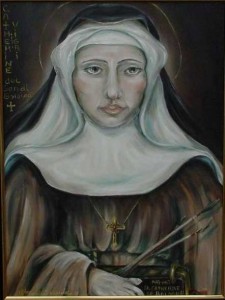 Patroness of Artists and Against Spiritual Temptation
Patroness of Artists and Against Spiritual Temptation
VATICAN CITY, 29 DEC 2010 (vatican.va) –
Dear Brothers and Sisters,
In a recent Catechesis I spoke of St Catherine of Siena. Today I would like to present to you another less well known Saint who has the same name: St Catherine of Bologna, a very erudite yet very humble woman. She was dedicated to prayer but was always ready to serve; generous in sacrifice but full of joy in welcoming Christ with the Cross. Catherine was born in Bologna on 8 September 1413, the eldest child of Benvenuta Mammolini and John de’ Vigri, a rich and cultured patrician of Ferrara, a doctor in law and a public lector in Padua, where he carried out diplomatic missions for Nicholas III d’Este, Marquis of Ferrara.
Not much information about Catherine’s infancy and childhood is available and not all of it is reliable. As a child she lived in her grandparents’ house in Bologna, where she was brought up by relatives, especially by her mother who was a woman of deep faith. With her, Catherine moved to Ferrara when she was about 10 years old and entered the court of Nicholas III d’Este as lady-in-waiting to Margaret, Nicholas’ illegitimate daughter. The Marquis was transforming Ferrara into a fine city, summoning artists and scholars from various countries. He encouraged culture and, although his private life was not exemplary, took great care of the spiritual good, moral conduct and education of his subjects. In Ferrara Catherine was unaware of the negative aspects that are often part and parcel of court life. She enjoyed Margaret’s friendship and became her confidante. She developed her culture by studying music, painting and dancing; she learned to write poetry and literary compositions and to play the viola; she became expert in the art of miniature-painting and copying; she perfected her knowledge of Latin. In her future monastic life she was to put to good use the cultural and artistic heritage she had acquired in these years. She learned with ease, enthusiasm and tenacity. She showed great prudence, as well as an unusual modesty, grace and kindness in her behaviour. However, one absolutely clear trait distinguished her: her spirit, constantly focused on the things of Heaven. In 1427, when she was only 14 years old and subsequent to certain family events, Catherine decided to leave the court to join a group of young noble women who lived a community life dedicating themselves to God. Her mother trustingly consented in spite of having other plans for her daughter. We know nothing of Catherine’s spiritual path prior to this decision. Speaking in the third person, she states that she entered God’s service, “illumined by divine grace… with an upright conscience and great fervourâ€, attentive to holy prayer by night and by day, striving to acquire all the virtues she saw in others, “not out of envy but the better to please God in whom she had placed all her love†(Le sette armi necessarie alla battaglia spirituali, [The seven spiritual weapons], VII, 8, Bologna 1998, p. 12). She made considerable spiritual progress in this new phase of her life but her trials, her inner suffering and especially the temptations of the devil were great and terrible. She passed through a profound spiritual crisis and came to the brink of despair (cf. ibid., VII, 2, pp. 12-29). She lived in the night of the spirit, and was also deeply shaken by the temptation of disbelief in the Eucharist.
After so much suffering, the Lord comforted her: he gave her, in a vision, a clear awareness of the Real Presence in the Eucharist, an awareness so dazzling that Catherine was unable to express it in words (cf. ibid., VIII, 2. pp. 42-46).
In this same period a sorrowful trial afflicted the community: tension arose between those who wished to follow the Augustinian spirituality and those who had more of an inclination for Franciscan spirituality. Between 1429 and 1430, Lucia Mascheroni, in charge of the group, decided to found an Augustinian monastery. Catherine, on the other hand chose with others to bind herself to the Rule of St Clare of Assisi. It was a gift of Providence, because the community dwelled in the vicinity of the Church of the Holy Spirit, annexed to the convent of the Friars Minor who had adhered to the movement of the Observance. Thus Catherine and her companions could take part regularly in liturgical celebrations and receive adequate spiritual assistance. They also had the joy of listening to the preaching of St Bernardine of Siena (cf. ibid., VII, 62, p. 26). Catherine recounts that in 1429 — the third year since her conversion — she went to make her confession to one of the Friars Minor whom she esteemed, she made a good Confession and prayed the Lord intensely to grant her forgiveness for all her sins and the suffering connected with them.
In a vision God revealed to her that he had forgiven her everything. It was a very strong experience of divine mercy which left an indelible mark upon her, giving her a fresh impetus to respond generously to God’s immense love (cf. ibid. IX, 2, pp. 46-48).
In 1431 she had a vision of the Last Judgement. The terrifying spectacle of the damned impelled her to redouble her prayers and penance for the salvation of sinners. The devil continued to assail her and she entrusted herself ever more totally to the Lord and to the Virgin Mary (cf. ibid., X, 3, pp. 53-54). In her writings, Catherine has left us a few essential notes concerning this mysterious battle from which, with God’s grace, she emerged victorious. She did so in order to instruct her sisters and those who intend to set out on the path of perfection: she wanted to put them on their guard against the temptations of the devil who often conceals himself behind deceptive guises, later to sow doubts about faith, vocational uncertainty and sensuality. In her autobiographical and didactic treatise, The Seven Spiritual Weapons, Catherine offers in this regard teaching of deep wisdom and profound discernment. She speaks in the third person in reporting the extraordinary graces which the Lord gives to her and in the first person in confessing her sins. From her writing transpires the purity of her faith in God, her profound humility, the simplicity of her heart, her missionary zeal, her passion for the salvation of souls. She identifies seven weapons in the fight against evil, against the devil:
1. always to be careful and diligently strive to do good;
2. to believe that alone we will never be able to do something truly good;
3. to trust in God and, for love of him, never to fear in the battle against evil, either in the world or within ourselves;
4. to meditate often on the events and words of the life of Jesus, and especially on his Passion and his death;
5. to remember that we must die;
6. to focus our minds firmly on memory of the goods of Heaven;
7. to be familiar with Sacred Scripture, always cherishing it in our hearts so that it may give direction to all our thoughts and all our actions.
A splendid programme of spiritual life, today too, for each one of us!
In the convent Catherine, in spite of being accustomed to the court in Ferrara, served in the offices of laundress, dressmaker and breadmaker and even looked after the animals. She did everything, even the lowliest tasks, with love and ready obedience, offering her sisters a luminous witness. Indeed she saw disobedience as that spiritual pride which destroys every other virtue. Out of obedience she accepted the office of novice mistress, although she considered herself unfit for this office, and God continued to inspire her with his presence and his gifts: in fact she proved to be a wise and appreciated mistress. Later the service of the parlour was entrusted to her. She found it trying to have to interrupt her prayers frequently in order to respond to those who came to the monastery grill, but this time too the Lord did not fail to visit her and to be close to her. With her the monastery became an increasingly prayerful place of self-giving, of silence, of endeavour and of joy. Upon the death of the abbess, the superiors thought immediately of her, but Catherine urged them to turn to the Poor Clares of Mantua who were better instructed in the Constitutions and in religious observance. Nevertheless, a few years later, in 1456, she was asked at her monastery to open a new foundation in Bologna. Catherine would have preferred to end her days in Ferrara, but the Lord appeared to her and exhorted her to do God’s will by going to Bologna as abbess. She prepared herself for the new commitment with fasting, scourging and penance. She went to Bologna with 18 sisters. As superior she set the example in prayer and in service; she lived in deep humility and poverty. At the end of her three-year term as abbess she was glad to be replaced but after a year she was obliged to resume her office because the newly elected abbess became blind. Although she was suffering and and was afflicted with serious ailments that tormented her, she carried out her service with generosity and dedication. For another year she urged her sisters to an evangelical life, to patience and constancy in trial, to fraternal love, to union with the divine Bridegroom, Jesus, so as to prepare her dowry for the eternal nuptials. It was a dowry that Catherine saw as knowing how to share the sufferings of Christ, serenely facing hardship, apprehension, contempt and misunderstanding (cf. Le sette armi spirituali, X, 20, pp. 57-58). At the beginning of 1463 her health deteriorated. For the last time she gathered the sisters in Chapter, to announce her death to them and to recommend the observance of the Rule. Towards the end of February she was harrowed by terrible suffering that was never to leave her, yet despite her pain it was she who comforted her sisters, assuring them that she would also help them from Heaven. After receiving the last Sacraments, she give her confessor the text she had written: The Seven Spiritual Weapons, and entered her agony; her face grew beautiful and translucent; she still looked lovingly at those who surrounded her and died gently, repeating three times the name of Jesus. It was 9 March 1463 (cf. I. Bembo, Specchio di illuminazione, Vita di S. Caterina a Bologna,Florence 2001, chap. III). Catherine was to be canonized by Pope Clement XI on 22 May 1712. Her incorrupt body is preserved in the city of Bologna, in the chapel of the monastery of Corpus Domini. Dear friends, with her words and with her life, St Catherine of Bologna is a pressing invitation to let ourselves always be guided by God, to do his will daily, even if it often does not correspond with our plans, to trust in his Providence which never leaves us on our own. In this perspective, St Catherine speaks to us; from the distance of so many centuries she is still very modern and speaks to our lives.
She, like us, suffered temptations, she suffered the temptations of disbelief, of sensuality, of a difficult spiritual struggle. She felt forsaken by God, she found herself in the darkness of faith. Yet in all these situations she was always holding the Lord’s hand, she did not leave him, she did not abandon him. And walking hand in hand with the Lord, she walked on the right path and found the way of light.
So it is that she also tells us: take heart, even in the night of faith, even amidst our many doubts, do not let go of the Lord’s hand, walk hand in hand with him, believe in God’s goodness. This is how to follow the right path!
And I would like to stress another aspect: her great humility. She was a person who did not want to be someone or something; she did not care for appearances, she did not want to govern. She wanted to serve, to do God’s will, to be at the service of others. And for this very reason Catherine was credible in her authority, because she was able to see that for her authority meant, precisely, serving others.
Let us ask God, through the intercession of Our Saint, for the gift to achieve courageously and generously the project he has for us, so that he alone may be the firm rock on which our lives are built. Thank you.
Tags: Bologna, catholic, catholic podcast, catholic prayer, cathollc spirituality, evil, faith, franciscan spirituality, mystic of the Church, poor clares, pope benedict xvi, Saint Catherine, spiritual weapons, st catherine of bologna, suffering, temptations, women of the middle ages
This entry was posted on Thursday, December 30th, 2010 at 5:53 am
You can follow any responses to this entry through the RSS 2.0 feed.
“Recalling with great fondness my four-day visit to the United Kingdom last September, I am glad to have the opportunity to greet you once again, and indeed to greet listeners everywhere as we prepare to celebrate the birth of Christ. Our thoughts turn back to a moment in history when God’s chosen people, the children of Israel, were living in intense expectation. They were waiting for the Messiah that God had promised to send, and they pictured him as a great leader who would rescue them from foreign domination and restore their freedom.”
“God is always faithful to his promises, but he often surprises us in the way he fulfils them.â€
“God is always faithful to his promises, but he often surprises us in the way he fulfils them. The child that was born in Bethlehem did indeed bring liberation, but not only for the people of that time and place – he was to be the Saviour of all people throughout the world and throughout history. And it was not a political liberation that he brought, achieved through military means: rather, Christ destroyed death for ever and restored life by means of his shameful death on the Cross. And while he was born in poverty and obscurity, far from the centres of earthly power, he was none other than the Son of God. Out of love for us he took upon himself our human condition, our fragility, our vulnerability, and he opened up for us the path that leads to the fullness of life, to a share in the life of God himself. As we ponder this great mystery in our hearts this Christmas, let us give thanks to God for his goodness to us, and let us joyfully proclaim to those around us the good news that God offers us freedom from whatever weighs us down: he gives us hope, he brings us life.
Dear Friends from Scotland, England, Wales and indeed every part of the English-speaking world, I want you to know that I keep all of you very much in my prayers during this Holy Season. I pray for your families, for your children, for those who are sick, and for those who are going through any form of hardship at this time. I pray especially for the elderly and for those who are approaching the end of their days. I ask Christ, the light of the nations, to dispel whatever darkness there may be in your lives and to grant to every one of you the grace of a peaceful joyful Christmas. May God bless all of you!” –BBC4
Tags: birth of christ, catholic, catholic podcast, catholic prayer, cathollc spirituality, faithful to his promises, pope benedict xvi
This entry was posted on Sunday, December 26th, 2010 at 9:20 am
You can follow any responses to this entry through the RSS 2.0 feed.
Tags: catholic, catholic podcast, catholic prayer, cathollc spirituality
This entry was posted on Saturday, December 25th, 2010 at 2:13 pm
You can follow any responses to this entry through the RSS 2.0 feed.
“In an instant, I saw five brilliant rays of light shine forth from his most holy wounds, and all came to my face.” St. Veronica Giuliani wrote these words more than three centuries ago, describing her mystical experience of Christ.
Vatican City, Dec 15, 2010 / 07:37 pm (vatican.va).-
Dear Brothers and Sisters,
Today I would like to present a mystic who did not live in the Middle Ages. She is St Veronica Giuliani, a Poor Clare Capuchin nun. The reason is that 27 December will be the 350th anniversary of her birth. Città di Castello, the place where she lived the longest and where she died, as well as Mercatello — her birthplace — and the Diocese of Urbino are celebrating this event with joy.
Indeed, Veronica was born on 27 December 1660 in Mercatello, in the Metauro Valley to Francesco Giuliani and Benedetta Mancini. She was the last of seven sisters, three of whom were to embrace the monastic life.
She was given the name “Orsola†[Ursula]. She was seven years old when her mother died and her father moved to Piacenza as customs superintendent of the Duchy of Parma. It was in this city that Ursula felt a growing desire to dedicate her life to Christ. The call to her became ever more pressing so that, when she was 17, she entered the strict cloister of the monastery of Capuchin Poor Clares in Città di Castello. She was to remain here for the rest of her life. Here she received the name of “Veronicaâ€, which means “true image†and she was in fact to become a true image of the Crucified Christ.
A year later she made her solemn religious profession and the process of configuration to Christ began for her, through much penance, great suffering, and several mystic experiences linked to the Passion of Jesus: being crowned with thorns, the mystical espousal, the wound in her heart and the stigmata.
In 1716, when she was 56, she became Abbess of the monastery. She was reconfirmed in this office until her death in 1727, after a very painful prolonged agony that lasted 33 days and culminated in a joy so profound that her last words were: “I have found Love, Love has let himself be seen! This is the cause of my suffering. Tell everyone about it, tell everyone!†(Summarium Beatificationis, 115-120).
On 9 July she left her earthly dwelling place for the encounter with God. She was 67 years old; 50 of those years she spent in the monastery of Città di Castello. She was canonized on May 26, 1893, by Pope Gregory XVI.
Veronica Giuliani wrote prolifically: letters, autobiographical reports, poems. However, the main source for reconstructing her thought is her Diary, which she began in 1693: about 22,000 handwritten pages that cover a span of 34 years of cloistered life.
Her writing flows spontaneously and continuously. There are no crossings-out, corrections or punctuation marks in it, nor was the material divided into chapters or parts according to a plan.
Veronica did not intend to compose a literary work; on the contrary, Fr Girolamo Bastianelli, a Filippini religious, in agreement with the diocesan Bishop Antonio Eustachi, obliged her to set down her experiences in writing.
St Veronica has a markedly Christological and spousal spirituality: She experienced being loved by Christ, her faithful and sincere Bridegroom, to whom she wished to respond with an ever more involved and passionate love. She interpreted everything in the key of love and this imbued her with deep serenity. She lived everything in union with Christ, for love of him, and with the joy of being able to demonstrate to him all the love of which a creature is capable.
The Christ to whom Veronica was profoundly united was the suffering Christ of the Passion, death and Resurrection; it was Jesus in the act of offering himself to the Father in order to save us.
Her intense and suffering love for the Church likewise stemmed from this experience, in its dual form of prayer and offering. The Saint lived in this perspective: she prayed, suffered and sought “holy povertyâ€, as one “dispossessed†and the loss of self (cf. ibid., III, 523), precisely in order to be like Christ who gave the whole of himself.
In every page of her writings Veronica commends someone to the Lord, reinforcing her prayers of intercession with the offering of herself in every form of suffering. Her heart dilated to embrace all “the needs of the Holy Churchâ€, living anxiously the desire for the salvation of “the whole world†(ibid., III-IV, passim).
Veronica cried: “O sinners… all men and all women, come to Jesus’ heart; come to be cleansed by his most precious blood…. He awaits you with open arms to embrace you†(ibid., II, 16-17).
Motivated by ardent love, she gave her sisters in the monastery attention, understanding and forgiveness. She offered her prayers and sacrifices for the Pope, for her Bishop, for priests and for all those in need, including the souls in Purgatory.
She summed up her contemplative mission in these words: “We cannot go about the world preaching to convert souls but are bound to pray ceaselessly for all those souls who are offending God… particularly with our sufferings, that is, with a principle of crucified life†(ibid., IV, 877). Our Saint conceived this mission as “being in the midst†of men and God, of sinners and the Crucified Christ.
Veronica lived profound participation in the suffering love of Jesus, certain that “to suffer with joy†is the “key to love†(cf. ibid., I, 299.417; III, 330.303.871; IV, 192). She emphasizes that Jesus suffers for humanity’s sins, but also for the suffering that his faithful servants would have to endure down the centuries, in the time of the Church, precisely because of their solid and consistent faith.
She wrote: “His Eternal Father made them see and feel the extent of all the suffering that his chosen ones would have to endure, the souls dearest to him, that is, those who would benefit from his Blood and from all his sufferings” (ibid., II, 170).
As the Apostle Paul says of himself: “Now I rejoice in my sufferings for your sake, and in my flesh I complete what is lacking in Christ’s afflictions for the sake of his Body, that is, the Church†(Col 1:24).
Veronica reached the point of asking Jesus to be crucified with him. “In an instantâ€, she wrote, “I saw five radiant rays issue from his most holy wounds; and they all shone on my face. And I saw these rays become, as it were, little tongues of fire. In four of them were the nails; and in one was the spear, as of gold, red hot and white hot: and it went straight through my heart, from one side to the other … and the nails pierced my hands and feet. I felt great pain but in this same pain I saw myself, I felt myself totally transformed into God†(Diary, I, 897).
The Saint was convinced that she was already participating in the Kingdom of God, but at the same time she invoked all the Saints of the Blessed Homeland to come to her aid on the earthly journey of her self-giving while she waited for eternal beatitude; this was her undying aspiration throughout her life (cf. ibid., II, 909; V, 246).
With regard to the preaching of that time which often focused on “saving one’s soul†in individual terms, Veronica shows a strong “sense of solidarityâ€, a sense of communion with all her brothers and sisters on their way towards Heaven and she lives, prays and suffers for all. The penultimate, earthly things, although appreciated in the Franciscan sense as gifts of the Creator, were always relative, altogether subordinate to “God’s taste†and under the sign of radical poverty.
In the communio sanctorum, she explains the gift of herself to the Church, as the relationship between the pilgrim Church and the heavenly Church. “All the Saintsâ€, she wrote, “are up there thanks to the merit and the Passion of Jesus; but they cooperated with all that the Lord did, so that their life was totally ordered … regulated by these same works (his)†(ibid., III, 203).
We find many biblical citations in Veronica’s writings, at times indirectly, but always precise. She shows familiarity with the Sacred Text, by which her spiritual experience was nourished. Furthermore, it should be pointed out that the intense moments of Veronica’s mystical experience are never separate from the salvific events celebrated in the Liturgy, where the proclamation of the Word of God and listening to it has a special place. Hence Sacred Scripture illumines, purifies and confirms Veronica’s experience, rendering it ecclesial. On the other hand, however, her experience itself, anchored in Sacred Scripture with uncommon intensity, guides one to a more profound and “spiritual†reading of the text itself, to enter into its hidden depths. Not only does she express herself with the words of Sacred Scripture but she also really lives by them, they take on life in her.
For example, our Saint often quotes the words of the Apostle Paul: “If God is for us, who is against us?†(Rom 8:31; cf. Diary, I, 714; II 116.1021; III, 48).
The assimilation of this Pauline text, her great trust and profound joy, becomes a fait accompliwithin her. “My soulâ€, she wrote, “was bound to the divine will and I was truly established and fixed for ever in the will of God. It seemed to me that I should never again have to be separated from this will of God and I came to myself with these precise words: nothing will be able to separate me from the will of God, neither anxieties, nor sorrows nor toil nor contempt nor temptation nor creatures nor demons nor darkness, not even death itself, because, in life and in death, I want all, and in all things, the will of God†(Diary, IV, 272). Thus we have the certainty that death is not the last word, we are fixed in God’s will, hence, truly, in eternal life.
In particular, Veronica proved a courageous witness of the beauty and power of Divine Love which attracted her, pervaded her and inflamed her. Crucified Love was impressed within her flesh as it was in that of St Francis of Assisi, with Jesus’ stigmata. “‘My Bride’, the Crucified Christ whispers to me, ‘the penance you do for those who suffer my disgrace is dear to me’…. Then detaching one of his arms from the Cross he made a sign to me to draw near to his side… and I found myself in the arms of the Crucified One. What I felt at that point I cannot describe: I should have liked to remain for ever in his most holy side†(ibid., I, 37).
This is also an image of her spiritual journey, of her interior life: to be in the embrace of the Crucified One and thus to remain in Christ’s love for others.
Veronica also experienced a relationship of profound intimacy with the Virgin Mary, attested by the words she heard Our Lady say one day, which she reports in her Diary: “I made you rest on my breast, you were united with my soul, and from it you were taken as in flight to God†(IV, 901).
St Veronica Giuliani invites us to develop, in our Christian life, our union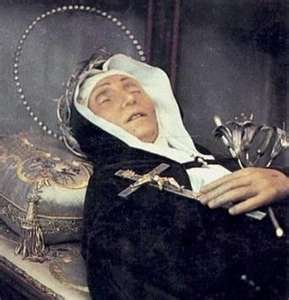 with the Lord in living for others, abandoning ourselves to his will with complete and total trust, and the union with the Church, the Bride of Christ.
with the Lord in living for others, abandoning ourselves to his will with complete and total trust, and the union with the Church, the Bride of Christ.
She invites us to participate in the suffering love of Jesus Crucified for the salvation of all sinners; she invites us to fix our gaze on Heaven, the destination of our earthly journey, where we shall live together with so many brothers and sisters the joy of full communion with God; she invites us to nourish ourselves daily with the Word of God, to warm our hearts and give our life direction. The Saint’s last words can be considered the synthesis of her passionate mystical experience: “I have found Love, Love has let himself be seen!â€. Thank you.
Tags: beauty, catholic, catholic podcast, catholic prayer, cathollc spirituality, christ in his suffering, Church, holy wounds, Jesus, mystic, mystic of the Church, mystical experiences, pope benedict, union with christ, veronica giuliani, witness
This entry was posted on Thursday, December 16th, 2010 at 6:03 am
You can follow any responses to this entry through the RSS 2.0 feed.

